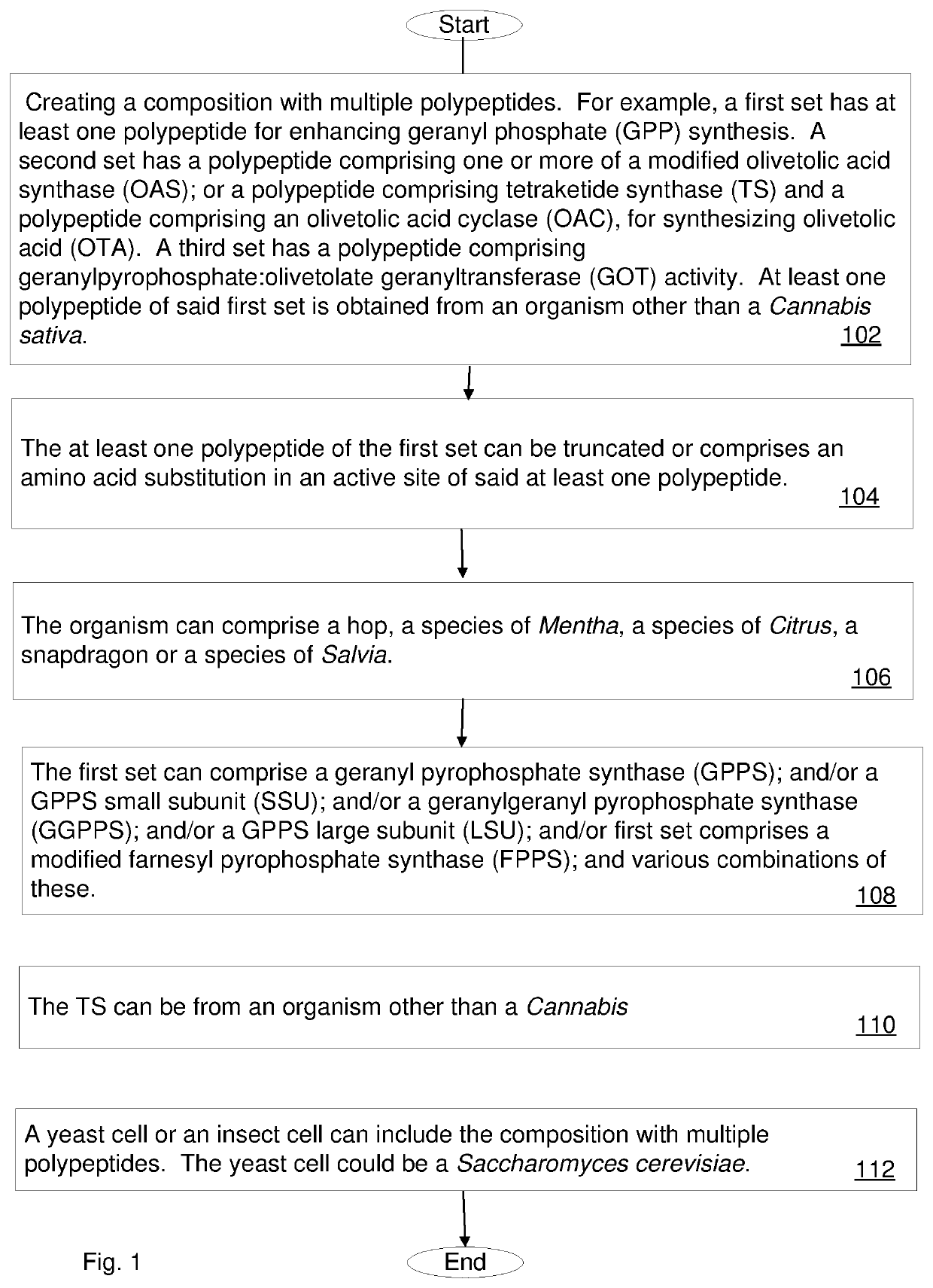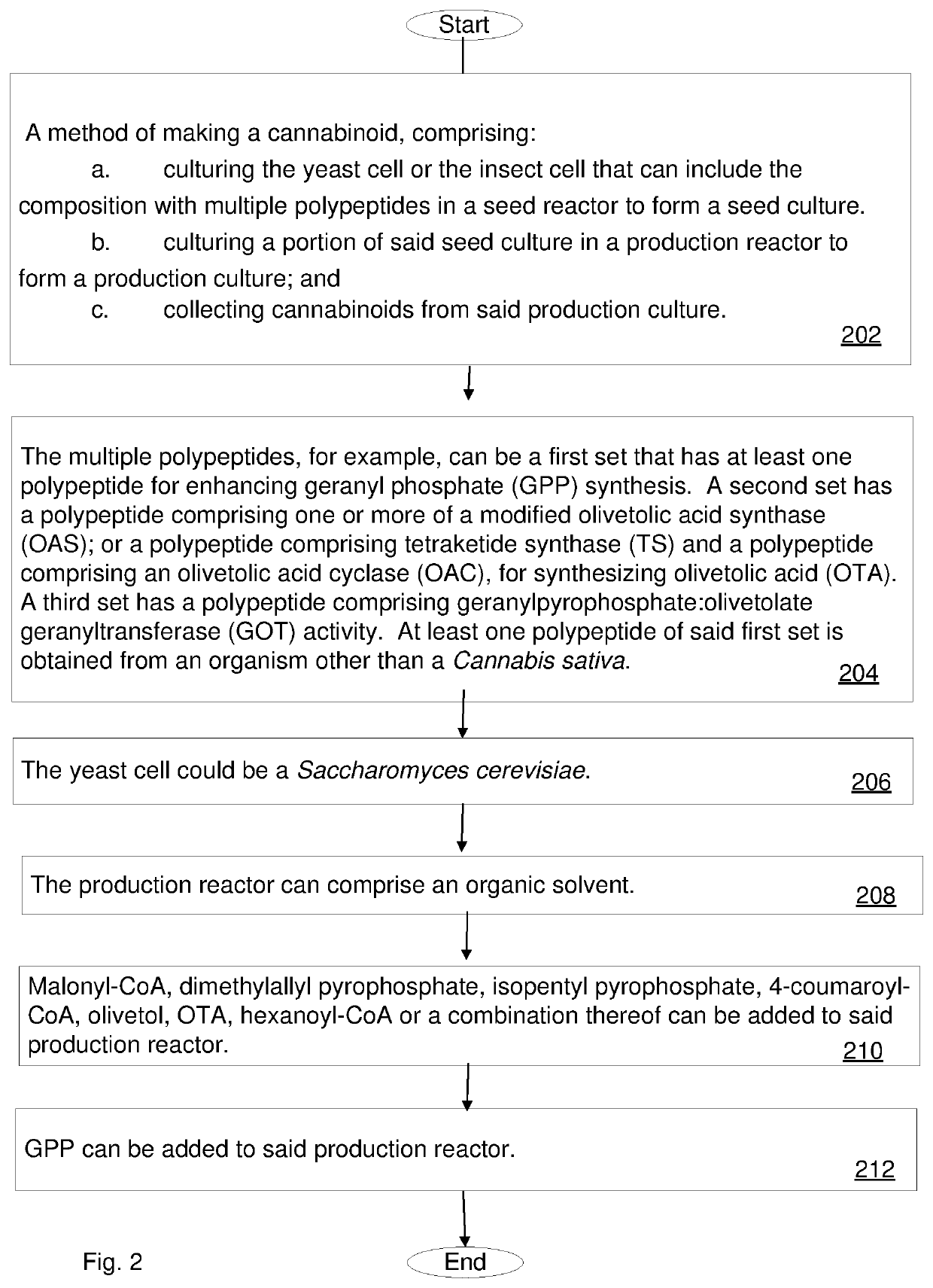Cannabinoid Production by Synthetic In Vivo Means
a technology of in vivo production and cannabinoid, which is applied in the field of new molecules, can solve the problems of poor or unsuccessful expression of heterologous host cells, non-cannabis /i>cells, and achieve the effect of facilitating the production of a desired produ
- Summary
- Abstract
- Description
- Claims
- Application Information
AI Technical Summary
Benefits of technology
Problems solved by technology
Method used
Image
Examples
example 1
[0195]Standard recombinant DNA and molecular cloning techniques used herein are known in the art and are described, for example, in Sambrook, et al. (supra); Silhavy et al., “Experiments with Gene Fusions,” Cold Spring Harbor Laboratory Press, Cold Spring, N.Y. (1984); and Ausubel et al., “Current Protocols in Molecular Biology,” Greene Publishing Assoc. and Wiley-Interscience (1987).
[0196]Nucleotide and amino acid percent identity and similarity comparisons can be made using the GCG suite of programs, applying default parameters, unless indicated otherwise.
example 2
[0197]C. sativa plants are grown under hydroponic conditions in a growth chamber. Approximately 5 g of mature female inflorescences 8 weeks after onset of flowering are collected. Tissue is macerated in phosphate-buffered saline (PBS) using a blender. Material is sieved and the flow-through is centrifuged. After another wash, pellets are resuspended in 100 μl of PBS. A suspension is estimated to contain about 100,000 intact glands.
[0198]Total RNA is isolated from the glands and about 100 ng of total RNA are used to make a cDNA library using a commercially available kit. Vectors can be configured to allow directional cloning of cDNA inserts. Plasmid DNA is isolated from selected clones and the inserts sequenced, for example, using an M13 forward primer that reads into 5′ end of the inserts.
[0199]Full length cDNA's with insert sequences substantially or identical to the TS sequence of Taura et at, supra, are isolated.
[0200]Polyketide synthase (PKS) assay for forming OL (160 μl reactio...
example 3
[0202]Full length cDNA's with insert sequences substantially or identical to GenBank accession JN 679224 are isolated.
[0203]OAC assay for forming OTA (50 μl reaction volume) contains 40 μl of enzyme, 20 mM Hepes buffer (pH 7), 5 μM DTT, 0.2 mM hexanoyl-CoA, 12 μg malonyl-CoA synthase, 0.2 mM CoA, 0.4 mM ATP, 2.5 mM MgCL2, 8 mM sodium malonate, TS and candidate OAC polypeptide. Boiled polypeptide as negative control is assayed in parallel with all reactions. All negative controls show a lack of OAC formation. Reactions are incubated for 1 h at 20° C. Products are identified by HPLC and / or MS.
[0204]Clones producing OTA are selected as OAC clones.
PUM
| Property | Measurement | Unit |
|---|---|---|
| OD | aaaaa | aaaaa |
| OD | aaaaa | aaaaa |
| pH | aaaaa | aaaaa |
Abstract
Description
Claims
Application Information
 Login to View More
Login to View More - R&D
- Intellectual Property
- Life Sciences
- Materials
- Tech Scout
- Unparalleled Data Quality
- Higher Quality Content
- 60% Fewer Hallucinations
Browse by: Latest US Patents, China's latest patents, Technical Efficacy Thesaurus, Application Domain, Technology Topic, Popular Technical Reports.
© 2025 PatSnap. All rights reserved.Legal|Privacy policy|Modern Slavery Act Transparency Statement|Sitemap|About US| Contact US: help@patsnap.com


